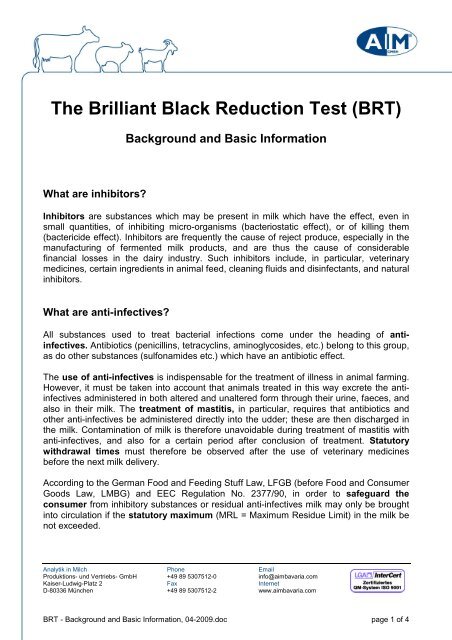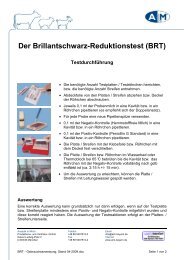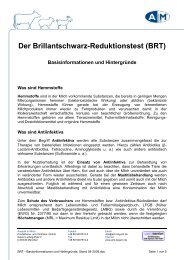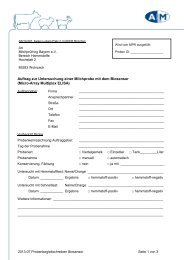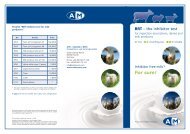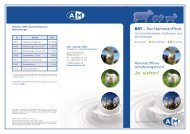BRT - Analytik in Milch Produktions- und Vertriebs GmbH
BRT - Analytik in Milch Produktions- und Vertriebs GmbH
BRT - Analytik in Milch Produktions- und Vertriebs GmbH
Create successful ePaper yourself
Turn your PDF publications into a flip-book with our unique Google optimized e-Paper software.
Inhibitors <strong>in</strong> milk and anti-<strong>in</strong>fectives <strong>in</strong> particular are a significant problem, both from thepo<strong>in</strong>t of view of consumer health and from that of dairy technology. It is therefore <strong>in</strong> the<strong>in</strong>terest of both, milk producers and milk process<strong>in</strong>g companies, as well as their legalresponsibility, only to circulate milk and milk products which are free of <strong>in</strong>hibitorysubstances or residues.In order to guarantee this, control <strong>in</strong>spections of the milk are necessary. Such <strong>in</strong>spectionsare carried out by the milk producers and the milk process<strong>in</strong>g companies, as well as by<strong>in</strong>dependent or governmental <strong>in</strong>spection laboratories, us<strong>in</strong>g reliable, standardised testmethods.Detection of <strong>in</strong>hibitors and residual anti-<strong>in</strong>fectives <strong>in</strong> milkMicrobiological <strong>in</strong>hibitor test systems are the most generally accepted world-wide forthe detection of <strong>in</strong>hibitors or residual anti-<strong>in</strong>fectives. Microbiological <strong>in</strong>hibitor tests areespecially suitable for rout<strong>in</strong>e <strong>in</strong>spections on account of their low cost, easy execution,relatively broad detection range and, <strong>in</strong> some cases, short test time (e.g. 2-3 hours for themost widely used test bacterium, Geobac. stearothermophilus var. calidolactis C953(before B. stearothermophilus).Test pr<strong>in</strong>ciple of the microbiological <strong>in</strong>hibitor testMicrobiological <strong>in</strong>hibitor tests operate by mak<strong>in</strong>g use of the sensitivity of specific microorganisms- so-called test bacteria - to antibiotics, sulfonamides and other <strong>in</strong>hibitors. The<strong>in</strong>hibitors lessen or prevent metabolic activity and thereby also the growth of the testbacteria. The thickness of the bacteria or the opacity of the test medium can be used as agauge to measure the amount of test bacterium growth. Acidification and reductionprocesses are used to measure metabolic activity with the help of coloured <strong>in</strong>dicators. Thecolour of the <strong>in</strong>dicator changes <strong>in</strong> the acidification process <strong>in</strong> response to the acidicmetabolic products of the grow<strong>in</strong>g test culture. In the reduction process, such as theBrilliant Black Reduction Test, the grow<strong>in</strong>g test culture reduces specific <strong>in</strong>dicators (e.g.brilliant black), which also leads to a colour change (e.g. from blue to yellow). Activity canhowever also be measured us<strong>in</strong>g other <strong>in</strong>dicators, such as pH value, degree of acidity,amount of lactic acid present, curdl<strong>in</strong>g time, or conductivity.One of the best-known and most widely-used procedures is the Brilliant BlackReduction Test (<strong>BRT</strong>).<strong>BRT</strong> - Backgro<strong>und</strong> and Basic Information, 04-2009.doc page 2 of 4
The Brilliant Black Reduction Test (<strong>BRT</strong>)The Brilliant Black Reduction Test (<strong>BRT</strong>) was first described <strong>in</strong> 1967 by KRAACK andTOLLE. Because of its reliability and easy execution it very quickly established a widedistribution base <strong>in</strong> dairy circles. The <strong>BRT</strong> stood out as a result of its stability <strong>in</strong> thepresence of different <strong>in</strong>fluenc<strong>in</strong>g factors. Various different milk products and also samplesof preserved milk can thus be tested us<strong>in</strong>g the <strong>BRT</strong>. Furthermore, automation of the testprocedure and also of the evaluation (photometric evaluation) is possible with largequantities. S<strong>in</strong>ce details of the <strong>BRT</strong> were first published, it has been and cont<strong>in</strong>ues to bemodified <strong>in</strong> different ways, with the aims of improv<strong>in</strong>g sensitivity of detection with regard toselected anti-<strong>in</strong>fective residues, simplify<strong>in</strong>g the execution procedure, or shorten<strong>in</strong>g the testtime.Experiences with the <strong>BRT</strong> show that this test method is easily standardised. The <strong>BRT</strong> hasestablished itself as an <strong>in</strong>ternationally recognised standard method, and is used not only<strong>in</strong> milk quality payment but also <strong>in</strong> quality control <strong>in</strong> dairy <strong>in</strong>dustry and <strong>in</strong> monitor<strong>in</strong>g<strong>in</strong>spections as a screen<strong>in</strong>g method for the detection of anti-<strong>in</strong>fectives. Alongside itsfunction as the <strong>BRT</strong> Inhibitor Test, the <strong>BRT</strong> thus also has a role <strong>in</strong> rout<strong>in</strong>e <strong>in</strong>spection, <strong>in</strong>its modified form, as the <strong>BRT</strong> MRL Screen<strong>in</strong>g Test.Test pr<strong>in</strong>ciple of the Brilliant Black Reduction TestWith the <strong>BRT</strong>, the test medium is conta<strong>in</strong>ed <strong>in</strong> cavities, or wells, <strong>in</strong> microtiter test plates orampoules. This test medium is a mixture of nutrients, test bacteria Geobac.stearothermophilus var. calidolactis C953 (before B. stearothermophilus), brilliant black,and other supplements which help improve detection sensitivity towards chosen <strong>in</strong>hibitors.The milk samples are pipetted <strong>in</strong>to the wells. Any <strong>in</strong>hibitors present can then diffusethroughout the test medium. Dur<strong>in</strong>g <strong>in</strong>cubation the grow<strong>in</strong>g test bacteria shift the redox<strong>in</strong>dicator (brilliant black) to its yellow or colourless reduction stage through the division ofdouble azocompo<strong>und</strong>s, and the test medium changes from blue to yellow. If <strong>in</strong>hibitors arepresent <strong>in</strong> the sample, growth will be m<strong>in</strong>imal or non-existent. There will then be noreduction of the colour<strong>in</strong>g agent, or to only a very small degree, and the test medium willrema<strong>in</strong> blue.Official description of the methodWith<strong>in</strong> the European Union, uniform European maximums (MRL = Maximum ResidueLimit) for veter<strong>in</strong>ary medic<strong>in</strong>al residues <strong>in</strong> foodstuffs of animal orig<strong>in</strong>, and thereby also <strong>in</strong>milk, were set down by law <strong>in</strong> EEC Regulation No. 2377/90. A microbiological <strong>in</strong>hibitor testfor the qualitative detection of antibiotics and sulfonamides <strong>in</strong> both raw and heat-treatedmilk which is required to conta<strong>in</strong> the test bacterium Bacillus stearothermophilus var.calidolactis is described <strong>in</strong> the decision of the Commission (91/180/EEC). The BrilliantBlack Reduction Test is one such procedure.In 1982 the <strong>BRT</strong> was recognised <strong>in</strong> Germany as an official <strong>in</strong>spection method for thedetection of <strong>in</strong>hibitors <strong>in</strong> tanker milk, and was accorded a place <strong>in</strong> the official register of<strong>in</strong>spection procedures accord<strong>in</strong>g to § 35 LMBG (now § 64 LFGB). S<strong>in</strong>ce then the methodhas been amended many times, most recently <strong>in</strong> February 1996.<strong>BRT</strong> - Backgro<strong>und</strong> and Basic Information, 04-2009.doc page 3 of 4
The <strong>BRT</strong> systems of <strong>Analytik</strong> <strong>in</strong> <strong>Milch</strong> <strong>GmbH</strong>AiM offers the follow<strong>in</strong>g <strong>BRT</strong> systems:<strong>BRT</strong> Inhibitor TestThis test was developed especially for the detection of <strong>in</strong>hibitors <strong>in</strong> milk, and dist<strong>in</strong>guishesitself by its particularly high sensitivity to β-lactam antibiotic residues. The maximumresidue limits (MRLs) laid down by the EU are reliably encompassed by the <strong>BRT</strong> InhibitorTest (see follow<strong>in</strong>g table); other antibiotics and sulfonamides present will also bedetected.The <strong>BRT</strong> Inhibitor Test is particularly designed to fulfil the demands of milkquality regulation <strong>in</strong> Germany, but can also be used successfully <strong>in</strong> other countries <strong>in</strong>quality evaluation and payment for tanker milk. It is produced accord<strong>in</strong>g to CommissionDecision 91/180/EEC and § 64 LFGB (before § 35 LMBG) Method 01.01-5.<strong>BRT</strong> MRL Screen<strong>in</strong>g TestThe MRL Screen<strong>in</strong>g Test is a modified <strong>BRT</strong> which is dist<strong>in</strong>guished by an <strong>in</strong>creasedsensitivity towards certa<strong>in</strong> antibiotics and sulfonamides. Besides the statutory maximums(MRLs) for β-lactam antibiotics, the test also encompasses substances from thesulfonamide group, macrolide group and am<strong>in</strong>oglycoside group to MRL level. Othersubstance groups are also detected with greater sensitivity than <strong>in</strong> the <strong>BRT</strong> Inhibitor Test(see follow<strong>in</strong>g table). The MRL Screen<strong>in</strong>g Test is used as a screen<strong>in</strong>g method for thedetection of anti-<strong>in</strong>fectives <strong>in</strong> quality control <strong>in</strong> dairy <strong>in</strong>dustry as well as <strong>in</strong> monitor<strong>in</strong>g tests.It is produced accord<strong>in</strong>g to Commission Decision 91/180/EEC and § 64 LFGB (before §35 LMBG) Method 01.00-11.Further <strong>in</strong>formation<strong>BRT</strong> – Backgro<strong>und</strong> and Basic Information<strong>BRT</strong> – Product Information<strong>BRT</strong> – Instructions for Use of Plates<strong>BRT</strong> – Instructions for Use of Tubes<strong>BRT</strong> – The Correct Incubation<strong>BRT</strong> – Use of Preserved Samples<strong>BRT</strong> – The Visual Evaluation<strong>BRT</strong> – The Photometric Evaluation<strong>BRT</strong> – Use of Milk ProductsStandards, lyophilisated – Product InformationPenicill<strong>in</strong>ase Product InformationShould you have any further questions or require any special <strong>in</strong>formation, please do nothesitate to contact us directly.<strong>BRT</strong> - Backgro<strong>und</strong> and Basic Information, 04-2009.doc page 4 of 4


